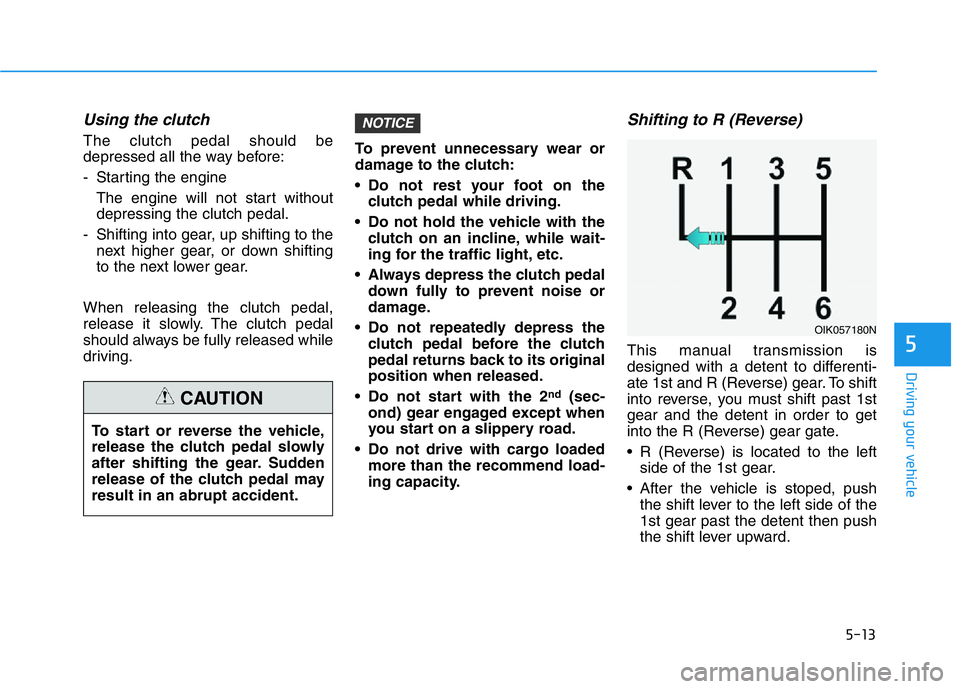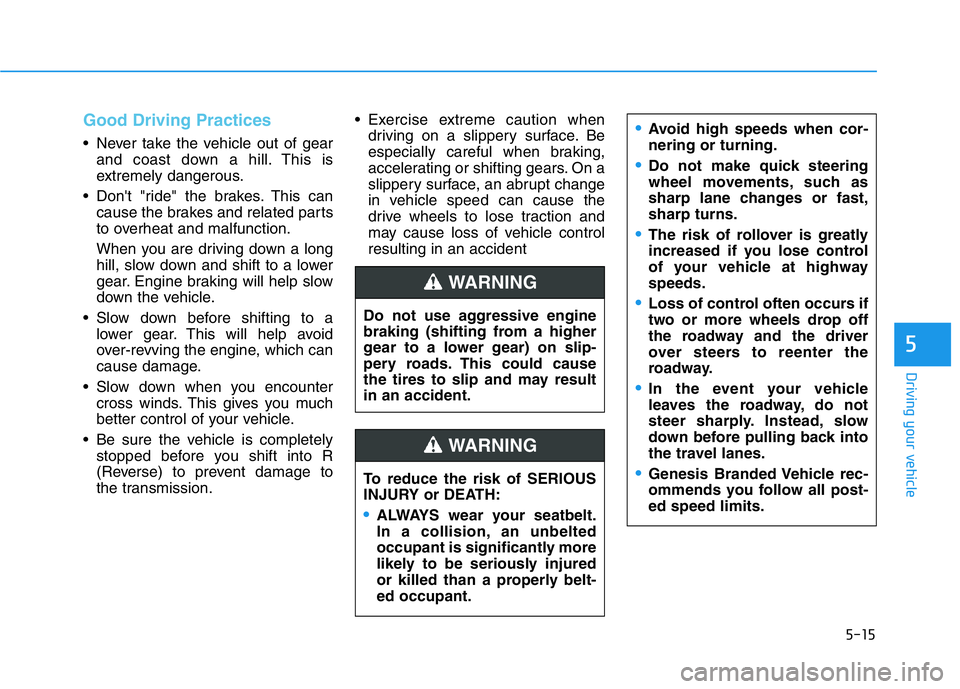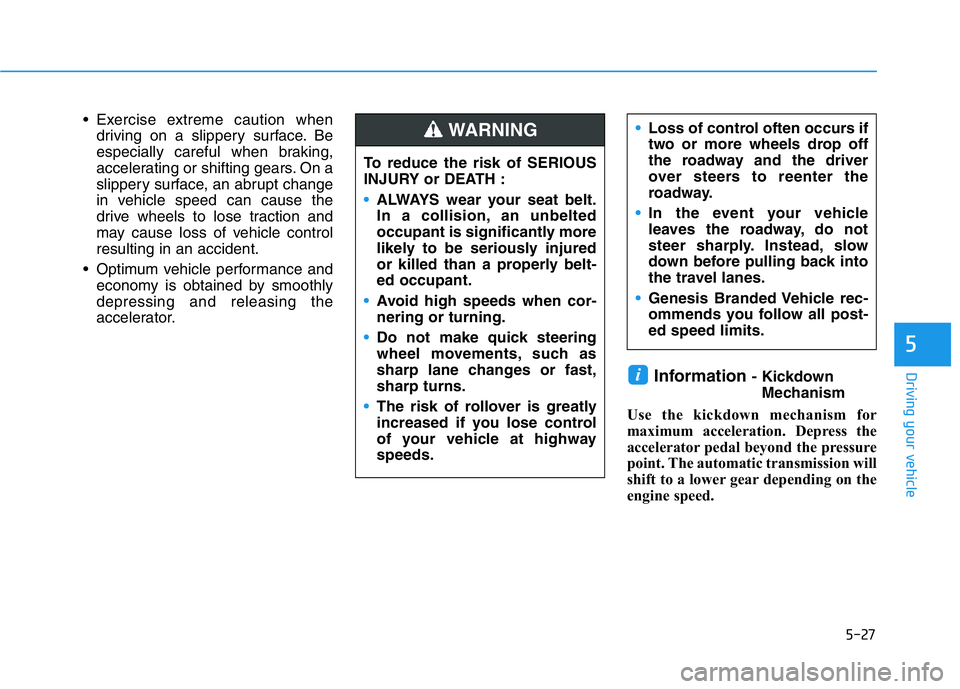Transmission GENESIS G70 2021 Owner's Guide
[x] Cancel search | Manufacturer: GENESIS, Model Year: 2021, Model line: G70, Model: GENESIS G70 2021Pages: 516, PDF Size: 12.84 MB
Page 262 of 516

5-13
Driving your vehicle
Using the clutch
The clutch pedal should be
depressed all the way before:
- Starting the engine
The engine will not start without
depressing the clutch pedal.
- Shifting into gear, up shifting to the
next higher gear, or down shifting
to the next lower gear.
When releasing the clutch pedal,
release it slowly. The clutch pedal
should always be fully released while
driving.To prevent unnecessary wear or
damage to the clutch:
• Do not rest your foot on the
clutch pedal while driving.
• Do not hold the vehicle with the
clutch on an incline, while wait-
ing for the traffic light, etc.
• Always depress the clutch pedal
down fully to prevent noise or
damage.
• Do not repeatedly depress the
clutch pedal before the clutch
pedal returns back to its original
position when released.
• Do not start with the 2
nd(sec-
ond) gear engaged except when
you start on a slippery road.
• Do not drive with cargo loaded
more than the recommend load-
ing capacity.
Shifting to R (Reverse)
This manual transmission is
designed with a detent to differenti-
ate 1st and R (Reverse) gear. To shift
into reverse, you must shift past 1st
gear and the detent in order to get
into the R (Reverse) gear gate.
• R (Reverse) is located to the left
side of the 1st gear.
• After the vehicle is stoped, push
the shift lever to the left side of the
1st gear past the detent then push
the shift lever upward.
NOTICE
5
To start or reverse the vehicle,
release the clutch pedal slowly
after shifting the gear. Sudden
release of the clutch pedal may
result in an abrupt accident.
CAUTION
OIK057180N
Page 263 of 516

5-14
• If you try to shift to the 1st gear
too quickly, it is possible to shift
to R (Reverse) instead of 1st
gear.
• Before driving you should learn
how to shift to R (Reverse), to
1st gear or 2nd gear.
• Shift to R only when the vehicle
is stationary. When the shift
lever is pressed to the left, a
slight resistance has to be over-
come.
• When shifting into 5th or 6th
gear, push the shift lever to the
right. Otherwise, inadvertently
shifting to the 3rd or 4th gear
may cause engine damage.
Downshifting
Down shift to a lower gear when
slowing down in heavy traffic or driv-
ing up a steep hill to prevent high
engine loads.
Also, downshifting reduces the
chance of stalling and helps reaccel-
erate the vehicle when you need to
increase your speed.
When the vehicle is going downhill,
downshifting helps maintain safe
speed by providing a load from the
engine and results in less wear on
the brakes.To prevent damage to the engine,
clutch and transmission:
• When downshifting from 5
th
gear to 4thgear, be careful not to
inadvertently push the shift
lever sideways engaging the 2
nd
gear. A drastic downshift may
cause the engine speed to
increase to the point the
tachometer will enter the red-
zone and may cause engine
damage.
• Do not downshift more than two
gear at a time or downshift the
gear when the engine is running
at high speed (5,000 rpm or
higher).
Such down shifting may damage
the engine, clutch and the trans-
mission.
NOTICENOTICE
Driving your vehicle
Page 264 of 516

5-15
Driving your vehicle
Good Driving Practices
• Never take the vehicle out of gear
and coast down a hill. This is
extremely dangerous.
• Don't "ride" the brakes. This can
cause the brakes and related parts
to overheat and malfunction.
When you are driving down a long
hill, slow down and shift to a lower
gear. Engine braking will help slow
down the vehicle.
• Slow down before shifting to a
lower gear. This will help avoid
over-revving the engine, which can
cause damage.
• Slow down when you encounter
cross winds. This gives you much
better control of your vehicle.
• Be sure the vehicle is completely
stopped before you shift into R
(Reverse) to prevent damage to
the transmission.• Exercise extreme caution when
driving on a slippery surface. Be
especially careful when braking,
accelerating or shifting gears. On a
slippery surface, an abrupt change
in vehicle speed can cause the
drive wheels to lose traction and
may cause loss of vehicle control
resulting in an accident
5
Do not use aggressive engine
braking (shifting from a higher
gear to a lower gear) on slip-
pery roads. This could cause
the tires to slip and may result
in an accident.
WARNING
•Avoid high speeds when cor-
nering or turning.
•Do not make quick steering
wheel movements, such as
sharp lane changes or fast,
sharp turns.
•The risk of rollover is greatly
increased if you lose control
of your vehicle at highway
speeds.
•Loss of control often occurs if
two or more wheels drop off
the roadway and the driver
over steers to reenter the
roadway.
•In the event your vehicle
leaves the roadway, do not
steer sharply. Instead, slow
down before pulling back into
the travel lanes.
•Genesis Branded Vehicle rec-
ommends you follow all post-
ed speed limits.To reduce the risk of SERIOUS
INJURY or DEATH:
•ALWAYS wear your seatbelt.
In a collision, an unbelted
occupant is significantly more
likely to be seriously injured
or killed than a properly belt-
ed occupant.
WARNING
Page 265 of 516

5-16
Driving your vehicle
Automatic Transmission
Operation
The automatic transmission has
eight forward speeds and one
reverse speed.
The individual speeds are selected
automatically in the D (Drive) posi-
tion.
AUTOMATIC TRANSMISSION
OIK057003
When you move the shift lever, depress the brake pedal while
pressing the UNLOCK button.
UNLOCK Button
P Button
Page 266 of 516

5-17
Driving your vehicle
5
Transmission ranges
The indicator in the instrument clus-
ter displays the gear position when
the Engine Start/Stop button is in the
ON position.
P (Park)
Always come to a complete stop
before shifting into P (Park).
To shift the gear from R (Reverse), N
(Neutral), D (Drive) or Manual shift
mode to P (Park), press the P button.
If you turn off the engine in D (Drive),
R (Reverse) or Manual shift mode
the shifting automatically changes to
P (Park).When you park the vehicle, press the
P button while depressing the brake
pedal and then apply the parking
brake.
OIK057004
To reduce the risk of serious
injury or death:
•ALWAYS check the surround-
ing areas near your vehicle for
people, especially children,
before shifting a vehicle into
D (Drive) or R (Reverse).
•Before leaving the driver's
seat, always make sure the
vehicle is shifted to the P
(Park) position, then apply the
parking brake, and press the
Engine Start/Stop button to
the OFF position. Unexpected
and sudden vehicle move-
ment can occur if these pre-
cautions are not followed.
•When using the paddle shifter
(manual mode), do not use
engine braking (shifting from
a high gear to lower gear) rap-
idly on slippery roads. The
vehicle may slip causing an
accident.
WARNING
•After the vehicle has stopped,
always make sure the vehicle
is in P (Park), apply the park-
ing brake, and turn the engine
off.
•When parking on an incline,
place the shift lever in P (Park)
and apply the parking brake to
prevent the vehicle from
rolling downhill.
WARNING
Page 267 of 516

5-18
Driving your vehicle
R (Reverse)
Use this position to drive the vehicle
rearward.To move the shift lever to R
(Reverse), press the UNLOCK but-
ton while depressing the brake pedal
and then move the shift lever for-
ward.
N (Neutral)
The wheels and transmission are not
engaged.
Use N (Neutral) if you need to restart
a stalled engine.
Shift into P (Park) if you need to
leave your vehicle for any reason.
Always depress the brake pedal
when you are shifting from N
(Neutral) to another gear.
In N (Neutral), if the driver attempts
to turn off the engine, the transmis-
sion remains in the N (Neutral) posi-
tion and the Engine Start/Stop button
will be in the ACC position.
OIK057005N
OIK057006N
■D (Drive) →R (Reverse)
■P (Park), N (Neutral) →R (Reverse)
Unlock Button
Unlock Button
Always come to a complete
stop before shifting into or out
of R (Reverse); you may dam-
age the transmission if you shift
into R (Reverse) while the vehi-
cle is in motion.
CAUTION
OIK057007N
■R (Reverse), D (Drive) →N (Neutral)
Page 268 of 516

5-19
Driving your vehicle
5
To turn off the engine from the ACC
position, press the Engine Start/Stop
button to the ON position, press the
P button, and then press the Engine
Start/Stop button to the OFF posi-
tion.
When either the driver's door or the
front passenger's door is opened
with the Engine Start/Stop button in
the ACC position and the shift lever
in N (Neutral) position, the engine is
automatically turned OFF and the
transmission automatically changes
to the P (Park) position.D (Drive)
This is the normal driving position.
The transmission will automatically
shift through an eight-gear
sequence, providing the best fuel
economy and power.
For extra power when passing anoth-
er vehicle or driving uphill depress
the accelerator pedal further until
you feel the transmission downshift
to a lower gear. •Do not shift into gear unless
your foot is firmly on the brake
pedal. Press the P (Park) but-
ton when idling the vehicle for
an extended period of time.
The wheels and the transmis-
sion are not engaged. When
parked with the engine run-
ning, press the P (Park) button
and apply the parking brake.
•Do not drive with the shift
lever in N (Neutral). Doing so
may result in an accident
because of a loss of engine
braking and the transmission
could be damaged.WARNING
Page 271 of 516

5-22
Driving your vehicle
To change back to the automatic shift
mode from manual shift mode, do
one of the following:
• Move the shift lever down toward
the D (Drive) position.
• Gently depress the accelerator
pedal for more than 5 seconds.
• Drive the vehicle under 4 mph (7
km/h).
• Pull and hold the right side paddle
shifter.
Information
If the [+] and [-] paddle shifters are
pulled at the same time, gear change
may not occur.
LCD Display Messages
Shifter system malfunction
The message appears on the LCD
display when the transmission or the
shift lever does not properly operate
in the P (Park) position.
Immediately have the vehicle
inspected by an authorized retailer of
Genesis Branded products.
Check shift lever
The message appears on the LCD
display when there is a malfunction
with one of the key transmission
shifter components.
Immediately have the vehicle
inspected by an authorized retailer of
Genesis Branded products.iOIK057042N
OIK057043L
Page 276 of 516

5-27
Driving your vehicle
5
• Exercise extreme caution when
driving on a slippery surface. Be
especially careful when braking,
accelerating or shifting gears. On a
slippery surface, an abrupt change
in vehicle speed can cause the
drive wheels to lose traction and
may cause loss of vehicle control
resulting in an accident.
• Optimum vehicle performance and
economy is obtained by smoothly
depressing and releasing the
accelerator.
Information - Kickdown
Mechanism
Use the kickdown mechanism for
maximum acceleration. Depress the
accelerator pedal beyond the pressure
point. The automatic transmission will
shift to a lower gear depending on the
engine speed.i
To reduce the risk of SERIOUS
INJURY or DEATH :
•ALWAYS wear your seat belt.
In a collision, an unbelted
occupant is significantly more
likely to be seriously injured
or killed than a properly belt-
ed occupant.
•Avoid high speeds when cor-
nering or turning.
•Do not make quick steering
wheel movements, such as
sharp lane changes or fast,
sharp turns.
•The risk of rollover is greatly
increased if you lose control
of your vehicle at highway
speeds.
•Loss of control often occurs if
two or more wheels drop off
the roadway and the driver
over steers to reenter the
roadway.
•In the event your vehicle
leaves the roadway, do not
steer sharply. Instead, slow
down before pulling back into
the travel lanes.
•Genesis Branded Vehicle rec-
ommends you follow all post-
ed speed limits.WARNING
Page 281 of 516

5-32
Driving your vehicle
• Do not apply the accelerator
pedal while the parking brake is
engaged. If you depress the
accelerator pedal with the park-
ing brake engaged, warning will
sound. Damage to the parking
brake may occur.
• Driving with the parking brake
on can overheat the braking sys-
tem and cause premature wear
or damage to brake parts. Make
sure the parking brake is
released and the Brake Warning
Light is off before driving.Check the Parking
Brake Warning Light
by pressing the Engine
Start/Stop button to
the ON position (do
not start the engine).
This light will be illuminated when the
parking brake is applied with the
Engine Start/Stop button in the
START or ON position.
Before driving, be sure the parking
brake is released and the Brake
Warning Light is OFF.
If the Parking Brake Warning Light
remains on after the parking brake is
released while engine is running,
there may be a malfunction in the
brake system. Immediate attention is
necessary.
If at all possible, cease driving the
vehicle immediately. If that is not pos-
sible, use extreme caution while
operating the vehicle and only con-
tinue to drive the vehicle until you
can reach a safe location.
NOTICE
•Only release the parking
brake when you are seated
inside the vehicle with your
foot firmly on the brake pedal.
•Whenever leaving the vehicle
or parking, always come to a
complete stop and continue
to depress the brake pedal.
Shift the vehicle to neutral (for
manual transmission vehicle)
or P (Park, for automatic
transmission vehicle), apply
the parking brake, and press
the Engine Start/Stop button
to the OFF position.
Vehicles with the parking
brake not fully engaged are at
risk for moving inadvertently
and causing injury to yourself
or others.
•When parking on an incline,
block the wheels to prevent
the vehicle from rolling down.
•NEVER allow anyone who is
unfamiliar with the vehicle to
touch the parking brake. If the
parking brake is released
unintentionally, serious injury
may occur.
WARNING